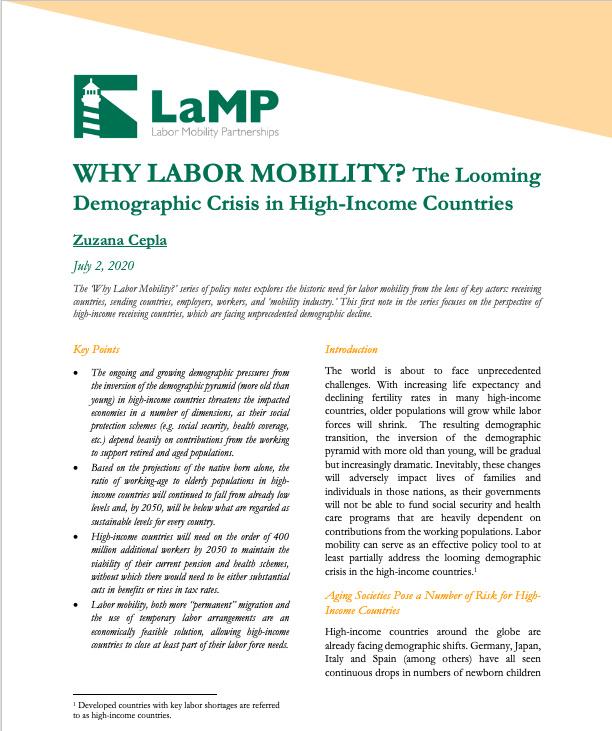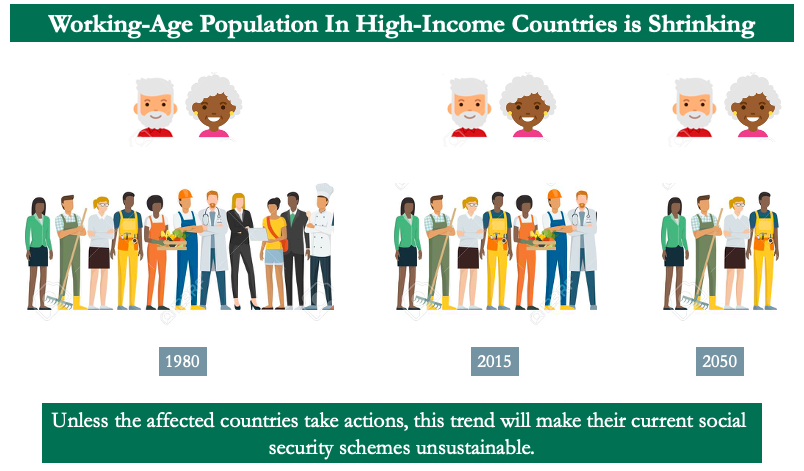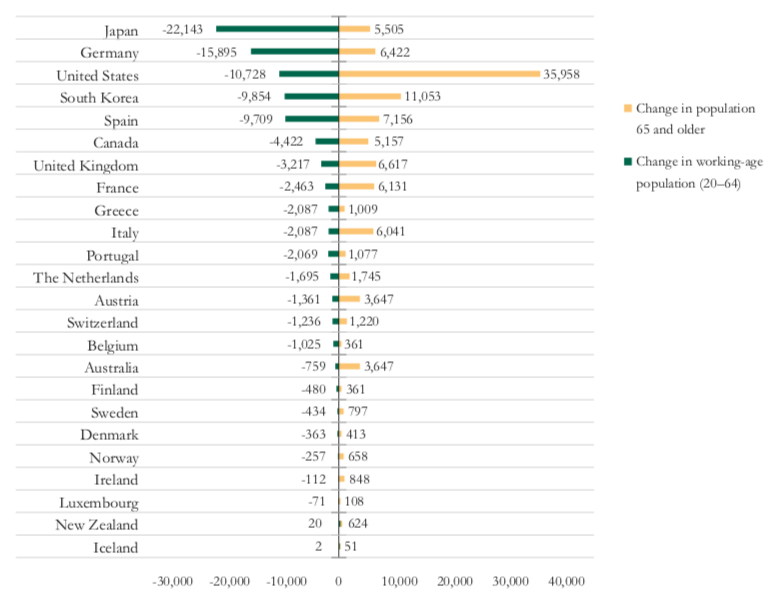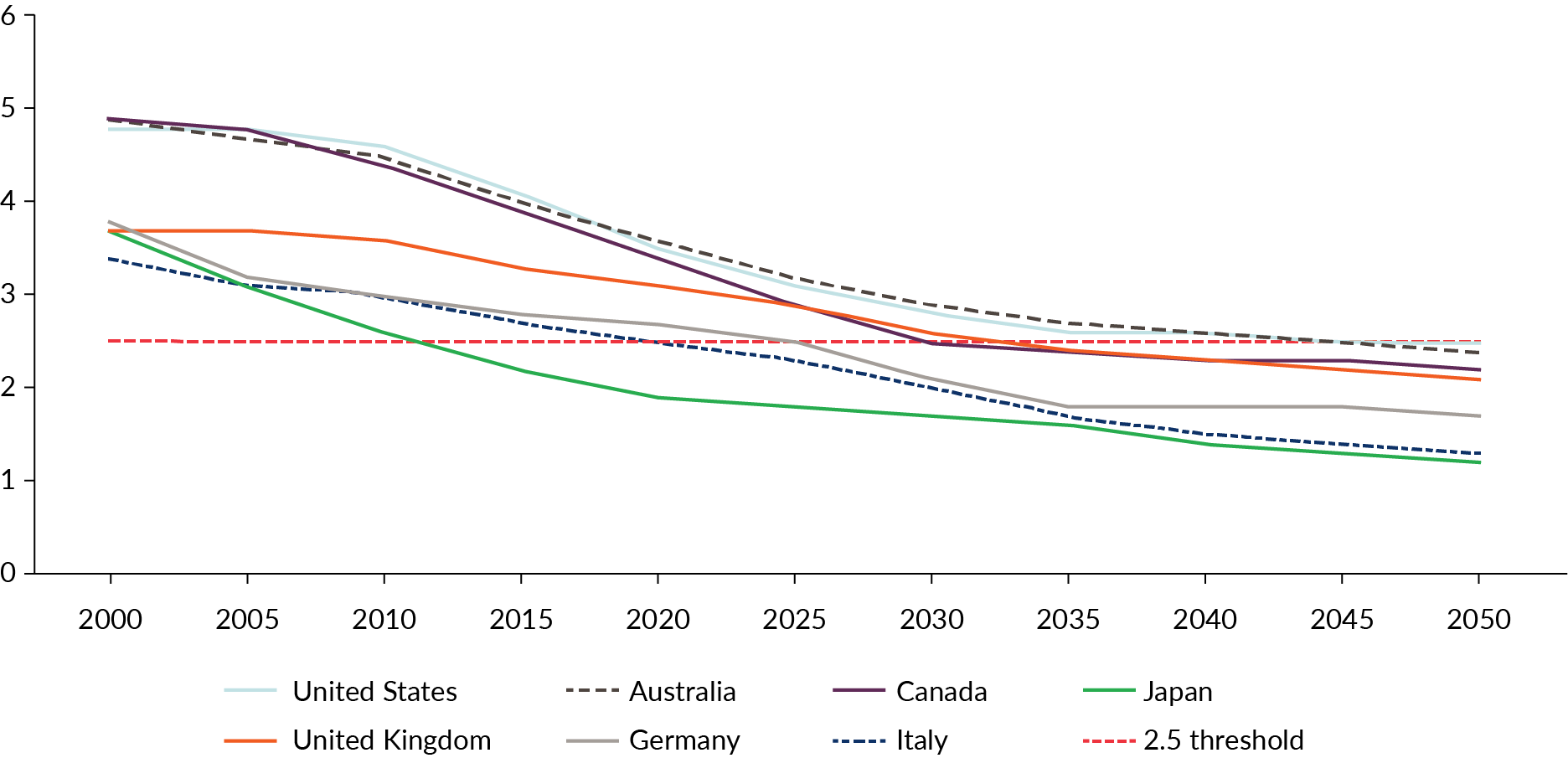
Why Labor Mobility?
The ‘Why Labor Mobility?’ series of policy notes explores the historic need for labor mobility from the lens of key actors:
- receiving countries
- sending countries
- employers, workers
- ‘mobility industry’
This first note in the series focuses on the perspective of high-income receiving countries, which are facing unprecedented demographic decline.
Key Points
- The ongoing and growing demographic pressures from the inversion of the demographic pyramid (more old than young) in high-income countries threatens the impacted economies in a number of dimensions, as their social protection schemes (e.g. social security, health coverage, etc.) depend heavily on contributions from the working to support retired and aged populations.
- Based on the projections of the native born alone, the ratio of working-age to elderly populations in high-income countries will continued to fall from already low levels and, by 2050, will be below what are regarded as sustainable levels for every country.
- High-income countries will need on the order of 400 million additional workers by 2050 to maintain the viability of their current pension and health schemes, without which there would need to be either substantial cuts in benefits or rises in tax rates.
- Labor mobility, both more “permanent” migration and the use of temporary labor arrangements are an economically feasible solution, allowing high-income countries to close at least part of their labor force needs.
Introduction
The world is about to face unprecedented challenges. With increasing life expectancy and declining fertility rates in many high-income countries, older populations will grow while labor forces will shrink. The resulting demographic transition, the inversion of the demographic pyramid with more old than young, will be gradual but increasingly dramatic. Inevitably, these changes will adversely impact lives of families and individuals in those nations, as their governments will not be able to fund social security and health care programs that are heavily dependent on contributions from the working populations. Labor mobility can serve as an effective policy tool to at least partially address the looming demographic crisis in the high-income countries.[1]
Aging Societies Pose a Number of Risk for High-Income Countries
High-income countries around the globe are already facing demographic shifts. Germany, Japan, Italy and Spain (among others) have all seen continuous drops in numbers of newborn children since at least the 1970s, with fertility rates well below the 2.1 level necessary for a population to replace itself.[i] These demographic changes are likely to burden the high-income countries mainly through their impact on social security nets – whether public or private – which depend heavily on contributions from working-age populations supporting the retirees. Similarly, health care programs in those countries also rely on contributions from the younger, whose health-care costs are typically much lower, to cover care for the elderly.[ii] Some authors warn that the countries may even enter a vicious cycle in which low fertility is passed from one generation to another. They argue that willingness to start a family depends partially on the couples’ ability to meet their material aspirations, but these desires are harder to achieve since the overall aging of the population puts more pressures on the younger generation’s finances.[iii]

In order to address these challenges, many high-income countries have implemented policies aiming at reducing impacts of this trend. Japan, for instance, has expanded its childcare services, parental schemes and child allowances to encourage higher fertility.[iv] However, its efforts appear to be largely unsuccessful as the country’s population remains among the fastest declining on the world. Unless countries find effective policies to address the issue, the effects of the ongoing demographic changes will be severe.
Besides the obvious consequences of the decreasing population, and the accompanying increase in the ratio of older, retirement aged to younger, such as inability to sustain social security schemes, there are other risks. There may be an overall economic slowdown since fewer people create less demand for goods and lower levels of investment. Others believe that the declines will slow down progress, and thus cause stagnation of living standards, as fewer people overall will imply there are less for all activities, including those devoted to the research and development activities that create productivity growth.[v]
The Crisis in Numbers
Estimates show that once the current Millennials (those born 1981 to 1996, aged 24 to 39 in 2020) in high-income countries around the world enter into their 50s and 60s in about thirty years, their entire generation will face these severe consequences of not having sufficiently large youth cohorts behind them. By 2050, in the absence of migration, the working-age populations of countries in the Organization for Economic Co-operation and Development (OECD)[2] is expected to decline by more than 92 million, while their elderly populations (over 65 years old) are predicted to
grow by more than 100 million people at the same time (Figure 1).[vi] Such dramatic demographic deficit pose potentially insuperable obstacles to funding existing welfare, pension, and health care programs in the rich countries.
Figure 1. While the working-age population in most OECD countries declines, these countries are gaining elderly citizens.

To prevent such scenario, the impacted countries have to find effective ways to grow their workforce to maintain sufficient balance between working-age populations and the retirees. In 2015, the median ratio of working-age populations to the elderly in the high-income countries was 3.3.[3] However, for example Japan’s ratio fell to 2.5 already in 2010.* These low ratios of young to old have never been seen in human history and most believe these are below levels at which countries can secure social
protections for their citizens at current contributions, but certainly no one can be sure these can support the existing social contracts. Estimates of populations without migration show that by 2050, the ratio in nearly every high-income country will be below the lowest in the world’s history before 2010, and on average will drop to 1.8 in a zero-net-migration scenario, and to 1.9 even in the UN’s status quo[4] scenario (Figure 2).[5]*
Figure 2. The declining ratio of working-age population to the elderly has been a persistent trend in OECD countries.

With fewer workers per retiree, it is unclear how governments can sustain their current social security and health care systems, indeed their fundamental existing social contract. Models show that if rich countries want to maintain their current – and already historically low – ratios of working-age to elderly populations through 2050, they will need more than 15 million workers per year, or a total of 400 million workers over the next 30 years (Figure 3).*
Such a number is massive. To put it into a perspective, the number is larger than entire population of North America (USA and Canada) as well as total population of West and North Europe, which accounts for 368 million and 302 million, respectively. In other words, the working-age population gap in the high-income countries is basically larger than overall population, including all age groups, of these two huge regions.[vii]
These projections of need for 400 million workers by 2050 are conservative as they understate the countries’ labor needs. The 400 million would only sustain the nations’ existing economic structure, which means they would likely need even more workers to sustain the current or achieve higher rates of economic growth. Moreover, the estimates assume that simply maintaining the balance between workforce and retirees is sufficient to meet labor demand.
However, several occupations, such as care services and construction, not only need more but also typically require younger workers. As people get older, the governments must ensure the economy has enough workers capable of providing more labor-intensive support that the aging populations need.[viii] For example, there were nearly 44,000 nursing vacancies in the UK at the end of 2019, and the number is projected to hit 100,000 by 2029.[ix] At the same time, about one in three UK nurses is expected to reach retirement age by 2026.[x] Also, the U.S. will need additional 203,700 new registered nurses each year through 2026 to meet the increasing demand and to replace retiring nurses.[xi] Already in 2010, majority of registered full-time and part-time registered nurses in the U.S. were between 45 and 59 years old. Overall, the U.S. expects 75 percent of the country’s workforce to turn 65 or older by 2050.[xii]
Figure 3. Massive labor shortages in selected OECD countries: Millions of new workers will be needed each year to maintain the current economic structure.

Policy Options for Addressing the Looming Demographic Crisis
Ensuring adequate job creation for their populations has been historically the primary policy concern for rich countries, with policies striving to employ their growing working-age populations. However, as the demographic crisis spreads, priorities of the impacted nations change from “How do we provide jobs to our working-age population?” to “How do we get more workers for the jobs that need to be done?”
There are several ways the high-income countries could try to address the issue, but since many of the potential solutions are quite difficult, or even impossible in some cases, politicians have taken little action on this pressing policy concern.[xiii] For example, the leaders could try to offset the demographic gaps with higher taxes. However, since the average tax-to-GDP ratio across the OECD countries has consistently stood at 34 percent, nearly unchanged since the late 1980’s despite various economic changes, it seems unlikely that the politicians would be able to convince the public about the need to raise taxes to substantially higher levels now.[xiv]
Alternatively, the countries could reduce benefits for their elderly populations – another potential solution that is easier said than done. When the French government tried to cut pension benefits, even modestly, the government faced a wave of massive protests and strikes against the proposed increase in retirement age and ultimately had to back down. Moreover, as the populations keep aging, they become an increasingly important voting bloc and politicians’ ability to cut retirement, social security, and health benefits for the elderly will decline even further.[xv] In Ireland, plans to increase pension age were one of the main concerns in the 2020 general election, which resulted in defeat of the country’s establishment heavy parties.[xvi]
Leaders could also try to increase the number of native workers by urging people to enlarge their families. However, this solution seems unreliable as well, as it is unlikely to produce sufficient and consistent results. While the governments can encourage their citizens to have more babies, families are unlikely to follow the recommendations at high enough rates without stronger social security nets. In Italy, the government tried to promote a “Fertility Day,” to encourage Italians to have more babies. However, the campaign instead spurred a backlash, with critics arguing the issue isn’t Italians’ unwillingness to have children but rather the lack of support provided to families by the government and employers.[xvii] Other countries, such as Luxemburg, Ireland and France, offer universal child benefits and other child-related programs,[xviii] and yet their fertility rates remain low.[xix]
The effects of this option would be also quite delayed as by the time the new generation reaches working age, the demographic issue will continue to deepen. Moreover, there is “reverse population momentum” and since, because the demographic pyramid is already thinned or inverted even higher fertility, births per woman, will have a hard time raising population growth as there are fewer and fewer women in the key reproductive ages, so even a return to previous fertility rates would only slow, not reverse, the demographic inversion.*
Finally, there is labor mobility, which is also seen as politically impossible, but perhaps it is the least impossible of the impossibilities.
Could foreign workers fill the demographic gaps and complement the native workforce in high-income countries? In order to maintain the ratio of working-age to elderly populations above the 2.5 sustainable threshold, rich countries will need about 400 million workers over the course of the next 30 years.[xx] As discussed above, the number is massive. If foreign source workers were to fill the gap, they would account for 40 percent of the entire working age population in the high-income countries.[xxi]
However, there is a potential pool of workers emerging outside of the developed world. In countries that are not aging nearly as fast or even struggle to employ their disproportionately high numbers of young individuals, many people seek to move to wealthier nations. Still, since only about 119 million migrants from developing countries lived in high-income nations in 2017, the flow would have to triple over the next 30 years.[xxii]
Labor mobility is unlikely to represent the sole answer to the demographic crisis; however, it is a realistic solution to at least partially closing the deepening gap. Moreover, besides balancing the demographic shifts, foreign workers bring new innovative ideas, foster economic growth, and enhance culture of the hosting nations.
In Australia, migration has played a major role in the last almost three decades of country’s economic expansion. Over the last couple of years, Australian real economic growth hovered around solid 2 to 2.5 percent, out of which nearly one percent was a result of migration.[xxiii] At the end of 2019 (before the onset of COVID-19) the country’s government even forecast a budget surplus for fiscal year 2020, attributable to an assumption of high net migration.[xxiv]
While some could argue that rather than labor mobility, the high-income countries could overcome the consequences of demographic changes with increases in productivity and advancement of technology, recent trends suggest the opposite. Even Japan, the most homogenous among OECD countries which has been able to persist with a ratio of working-age to elderly population of less than 2.5 for some time with high savings and advanced automation technologies, had announced launch of a pilot program in 2018 to bring in more than 300,000 workers over the following five years to fight labor shortages.
Moreover, the rich countries pursuing automation is a massive economic distortion and potentially has negative consequences for wages of workers both in their home countries and globally. Automation to displace low to medium skill labor is false economizing as labor is globally abundant and make locally scarce only by border-based barriers to movement.[xxv]
Overall, with the working-age to elderly population ratio falling to unsustainable levels, filling at least a portion of the labor deficit with foreign workers will help prevent a slowdown of the high-income countries’ economies and possibly even spur growth.
Conclusion
The world has been facing dramatic demographic shifts, which will have crucial implications for economies, fiscal balances, politics and societies in high-income countries. Labor mobility offers a politically difficult solution, but perhaps more plausible and feasible than all other options. Nations can at least partially reduce their labor force gaps caused by the ongoing demographic crisis by allowing more workers, who stand ready and willing, to come. There are also reasons to prefer labor mobility as a solution, as it fosters growth and brings innovation to the high-income countries along with a badly needed workforce. The issue is pressing. It is time for high-income countries to take action and invest into labor mobility systems, allowing for development of pathways through which foreign workers will be able to enhance economies and, rather than threaten, support existing desirable social arrangements.
About LaMP
Labor Mobility Partnerships (LaMP) aims to increase rights-respecting labor mobility, ensuring workers can access employment opportunities abroad. Its overarching goal is to make it easier for its partners to build labor mobility systems at the needed scale, thus unlocking billions in income gains to people filling the needed jobs. It focuses on connecting governments, employers and sectors, the mobility industry, and researchers and advocates to bridge gaps in international labor markets, and creating and curating a repository of knowledge and resources to design and implement mobility partnerships which benefit all involved. LaMP’s functions include brokering relationships between potential partners, providing technical support from design to implementation of partnerships, and research and advocacy around the impacts of successful partnerships.
[1] Developed countries with key labor shortages are referred to as high-income countries.
[2] Data used for this note considered the following OECD countries: Australia, Austria, Belgium, Canada, Denmark, Finland, France, Germany, Greece, Iceland, Ireland, Italy, Japan, Luxembourg, Netherlands, New Zealand, Norway, Portugal, South Korea, Spain, Sweden, Switzerland, the United States, and the United Kingdom.
[3] We use the zero-migration variant of the UN DESA, Population Division (2015) data, which assumes net international migration for countries at the beginning of the period to be zero.
[4] The status quo ratio equals to the 2015 ratios of working-age population to 65+ population.
[5] Projections of population change based on a probabilistic model of changes in fertility, and normal mortality and migration rates.
Endnotes
[i] “Fertility Rate, Total (Births per Woman),” accessed June 2, 2020, https://data.worldbank.org/indicator/SP.DYN.TFRT.IN?end=2018.
[ii] Lant Pritchett, “Only Migration Can Save the Welfare State,” Foreign Affairs, February 24, 2020, https://www.foreignaffairs.com/articles/2020-02-24/only-migration-can-save-welfare-state.
[iii] Robin Harding, “The Costs of a Declining Population” (Financial Times, January 14, 2020), https://www.ft.com/content/c017334e-36bb-11ea-a6d3-9a26f8c3cba4.
[iv] “Government Response to Low Fertility in Japan ”(United Nations), accessed June 2, 2020, at http://esa.un.org/PopPolicy/publications.aspx.
[v] Robin Harding, “The Costs of a Declining Population” (Financial Times, January 14, 2020), https://www.ft.com/content/c017334e-36bb-11ea-a6d3-9a26f8c3cba4.
[vi] UN DESA, Population Division (2015).
[vii] https://lampforum.org/2020/01/09/the-future-is-older/
[viii] Lant Pritchett, “Only Migration Can Save the Welfare State,” Foreign Affairs, February 24, 2020, https://www.foreignaffairs.com/articles/2020-02-24/only-migration-can-save-welfare-state.
[ix] “Nursing Shortages Forcing NHS to Rely on Less Qualified Staff – Report” (The Guardian, November 27, 2019), https://www.theguardian.com/society/2019/nov/28/nursing-shortages-forcing-nhs-england-wales-to-rely-on-less-qualified-staff-report.
[x] Rachel Marangozov, Matthew Williams, and James Buchan, “The Labour Market for Nurses in the UK and Its Relationship to the Demand for, and Supply of, International Nurses in the NHS” (Institute for Employment Studies, July 2016), https://assets.publishing.service.gov.uk/government/uploads/system/uploads/attachment_data/file/535657/The_labour_market_for_nurses_in_the_UK.pdf.
[xi] Elka Torpey, “Employment Outlook for Bachelor’s-Level Occupations : Career Outlook” (U.S. Bureau of Labor Statistics, April 2018), https://www.bls.gov/careeroutlook/2018/article/bachelors-degree-outlook.htm.
[xii] Sepi McDonnell, “America’s Nurses Are Aging” (Allied Staffing Network, February 14, 2017), https://alliedstaffingnetwork.com/americas-nurses-are-aging/.
[xiii] Lant Pritchett, “Only Migration Can Save the Welfare State,” Foreign Affairs, February 24, 2020, https://www.foreignaffairs.com/articles/2020-02-24/only-migration-can-save-welfare-state.
[xiv] Ibid.
[xv] Ibid.
[xvi] Patrick Collinson, “The French and the Irish Are Fighting Pension Age Rises – Will the British? | Patrick Collinson,” The Guardian (Guardian News and Media, February 14, 2020), https://www.theguardian.com/money/2020/feb/14/the-french-and-the-irish-are-fighting-pension-age-rises-will-the-british.
[xvii] Gaia Pianigiani, “Italy’s ‘Fertility Day’ Call to Make Babies Arouses Anger, Not Ardor” (The New York Times, September 13, 2016), https://www.nytimes.com/2016/09/14/world/europe/italy-births-fertility-europe.html.
[xviii] Dylan Matthews, “Sweden Pays Parents for Having Kids – and It Reaps Huge Benefits. Why Doesn’t the US?” (Vox, May 23, 2016), https://www.vox.com/2016/5/23/11440638/child-benefit-child-allowance.
[xix] “Fertility Rate, Total (Births per Woman),” accessed June 2, 2020, https://data.worldbank.org/indicator/SP.DYN.TFRT.IN?end=2018.
[xx] Lant Pritchett, “Only Migration Can Save the Welfare State,” Foreign Affairs, February 24, 2020, https://www.foreignaffairs.com/articles/2020-02-24/only-migration-can-save-welfare-state.
[xxi] Lant Pritchett, “The Future Is Older” (Labor Mobility Partnerships, January 9, 2020), https://lampforum.org/2020/01/09/the-future-is-older/.
[xxii] Ibid.
[xxiii] Evan Young, “Coronavirus Has Halted Immigration to Australia and That Could Have Dire Consequences for Its Economic Recovery” (SBS News, April 1, 2020), https://www.sbs.com.au/news/coronavirus-has-halted-immigration-to-australia-and-that-could-have-dire-consequences-for-its-economic-recovery.
[xxiv] David Crowe, “Budget Surplus under Threat as Treasury Considers Coronavirus ‘Wildcard’,” The Sydney Morning Herald (The Sydney Morning Herald, February 17, 2020), https://www.smh.com.au/politics/federal/budget-surplus-under-threat-as-treasury-considers-coronavirus-wildcard-20200217-p541nf.html.
[xxv] Acemoglu, Daron, and Pascual Restrepo. Rep. Low-Skill and High-Skill Automation. Journal of Human Capital, 2018. https://economics.mit.edu/files/15118.
